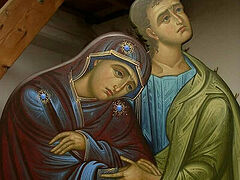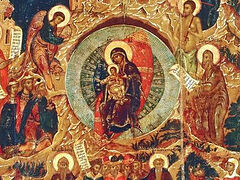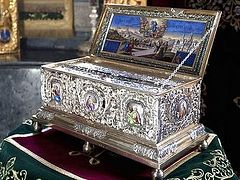According to an ancient Church tradition, when leaving this world in order to unite with Her Son and the Lord, the Most Holy Theotokos bequeathed two of Her garments to two poor Jewish women who served Her. They carefully preserved these relics, passed down from generation to generation. In the reign of Leo I, Christians Galvius and Candide received the robe of the Virgin, resorting to a pardonable trick, and put it in the Blachernae Church.1
The belt of the Virgin was found under unknown circumstances in the diocese of Zela, near Amasia in Pontus. Around 530, during the reign of Justinian, it was brought to Constantinople2 and laid in the Chalcopratian Church, located west of St. Sophia, in the quarter of the coppersmiths. On this day, the patronal feast and the memory of the finding of two precious relics stored there—the honorable Cincture of the Virgin and the Winding Sheets of Christ were celebrated in the Chalcopratian church.
Many years later (ca. 888), Zoe, the wife of Emperor Leo VI the Wise, became seriously ill due to the action of an unclean spirit. She had a dream in which it was revealed to her that she would be healed if the Cincture of the Virgin was placed on her. The emperor immediately ordered to break the seals on the shrine with the relic and was amazed to see the honest Cincture sparkling and clean, as if woven yesterday. There was a note next to it, in which the day of the Cincture’s transfer to Constantinople was named and it was told how the emperor himself put it in this shrine and sealed it with his own hand. Emperor Leo venerated the relic with reverence and handed it to the Patriarch. He placed the Cincture on the head of the Empress, and she was immediately cured of her illness. Everyone praised Christ the Savior and His Most Pure Mother. The grateful Empress embroidered the Belt with gold threads, and the holy relic was again placed in the shrine.
According to legend, the Bulgarian tsar Ivan Asen (1187–1196), having defeated the Emperor Isaac II Angelos (1190), captured a cross with a piece of the honorable Cincture embedded in it. This cross was thrown by a certain priest into the river so that he would not be desecrated. The shrine then came into the hands of the Serbs and was subsequently transferred by Prince Lazar (†1389) to the Mount Athos monastery of Vatopedi. There it is revered to this day. The holy relic exudes a sweet fragrance, and numerous miracles are wrought from it.
The honorable cincture, which touched the Most Pure Womb that bore the Creator, and was moistened with drops of milk that nourished Him Who is the Life of the world, is for all Christians a testimony of salvation. It literally tells us that it is necessary to bridle all the movements of the flesh and emulate the spiritual and bodily purity of the Blessed Virgin and Mother of God in order to be worthy to bear Christ in your heart, Who forever becomes a Babe for our sakes.
From the Synaxarion of the Lives of the Saints of the Orthodox Church, Sretensky Monastery.




